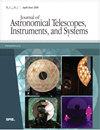Characterization of a hybrid array of single and multi-absorber transition-edge sensor microcalorimeters for the Line Emission Mapper
IF 3.1
3区 工程技术
Q2 ENGINEERING, AEROSPACE
Journal of Astronomical Telescopes Instruments and Systems
Pub Date : 2023-10-20
DOI:10.1117/1.jatis.9.4.041006
引用次数: 0
Abstract
. The Line Emission Mapper (LEM) is a proposed x-ray probe mission to study the physics of galaxy formation through spectral and spatial measurements of x-rays in the energy band of 0.2 to 2 keV. The LEM Microcalorimeter Spectrometer instrument on LEM will have a hybrid transition-edge sensor (TES) microcalorimeter array made up of an inner array of single-pixels with one x-ray absorber connected to one TES and an outer array of multi-absorber microcalorimeters, or “ hydras, ” with four absorbers connected to a single TES, each with a different thermal conductance. Here, we characterize the first hybrid array of single-pixel and multi-absorber micro-calorimeters designed for LEM. We present the fundamental transition, noise, and detector performance properties to demonstrate their suitability for the mission. We also show that the spectral resolution at the Al K α line is 1 . 92 (cid:1) 0 . 02 eV for the 4-pixel hydra (coadded) and 0 . 90 (cid:1) 0 . 02 eV for the single-pixels. This is significantly better resolution than the LEM mission level requirement. Finally, we demonstrate that the position discrimination between the four pixels of the hydra can be achieved down to 200 eV when measured with a time-division multiplexed readout using timings representative of the anticipated LEM requirements. © The Authors. Published by SPIE under a Creative Commons Attribution 4.0 International License. Distribution or reproduction of this work in whole or in part requires full attribution of the original publication, including its DOI. [DOI: 10.1117/1.JATIS.9.4.041006线发射成像仪中单吸收体和多吸收体过渡边缘传感器微热计混合阵列的表征
本文章由计算机程序翻译,如有差异,请以英文原文为准。
求助全文
约1分钟内获得全文
求助全文
来源期刊

Journal of Astronomical Telescopes Instruments and Systems
Engineering-Mechanical Engineering
CiteScore
4.40
自引率
13.00%
发文量
119
期刊介绍:
The Journal of Astronomical Telescopes, Instruments, and Systems publishes peer-reviewed papers reporting on original research in the development, testing, and application of telescopes, instrumentation, techniques, and systems for ground- and space-based astronomy.
 求助内容:
求助内容: 应助结果提醒方式:
应助结果提醒方式:


